|

|
ENGINEERING
EXERCISES IN THE REGION--Continued
| Begun
originally as road and bridge building exercises (first in Panama
1984-1985 then Honduras, this exercise program had integrated since 1990
vertical construction projects (constructing or repairing schools,
medical clinics, basic sanitation facilities, and other public-use
facilities) and drilling potable water wells. (From 1990 through 1995,
these exercises were called Fuertes Caminos --Spanish for Strong Roads, and various other names between 1984 and
1990. Also, other names for the exercises were used for certain
countries in coordination with those governments.)
From 1984 through 2005,
such engineering exercises have been
conducted by U.S. forces working with host nation personnel in
Panama (except 1987-1989 due the increasing political crisis
there), all six countries in Central America, six South American
countries, and 11 island nations in the Caribbean (the
last since the area came part of the Southern Command's area of
operational responsibility for U.S. military activities in
1996). (See chart 1 -
Humanitarian Assistance Engineering/Medical Exercises in the
Region Since 1984 - by Year and Chart
2 - Humanitarian Assistance Engineering/Medical Exercises in
the Region Since 1984 - by Country.)
OBJECTIVES
These military engineering
activities have become a major component of the United States
Southern Command's strategy of peacetime engagement: namely,
nation assistance, promoting democracy, and enhancing the role of
the military in a democratic society. Nation assistance activities
contribute to the ultimate goal of host nations establishing
self-sustaining institutions and capabilities for nation building
and development.
These exercises are designed to:
 | First and foremost, provide
unique realistic training
for U.S. military units (particularly U.S. National Guard and
Reserve units) in deployments to and operating in unfamiliar remote, austere environments overseas they might see in future
operations (such as natural disaster relief assistance). Projects are designed to provide training in their
engineer, medical, or support specialties while working with host nation military and civilian personnel in construction
projects. Upon completion of the exercise, the forces redeploy to their home stations. By participating in
these exercises, U.S. military personnel practice their skills in
tangible projects and
test their readiness which leads to enhancing U.S. military operational readiness
through honing their military
specialties.
The results of such exercises
are not only improved skills and greater inter-operability
between the Reserve component forces and active-duty military
units (as well as host-nation militaries and/or civilian
agencies) but also services and products for the benefit of
the most underserved people in the host nations -- namely,
improved or new roads and bridges, educational and medical
facilities, potable water wells, and medical and dental care.
(Such training opportunities are not
available in the United States where the military is prohibited by
law from competing with private enterprise.) |
 | Assist host nations in their
efforts to develop, restructure, and reinforce democratic
institutions. They assist in enhancing the nations'
humanitarian and civic action capabilities, specifically those
of their security forces, for the benefit of their people. (Such
exercises took on additional significance in El Salvador and
Nicaragua beginning in the mid-1990s following their civil
wars throughout the 1980s. |
 | Foster goodwill and improve
relations between the United States and the host nation. |
 | Demonstrate continued United
States support in strengthening democracy in Latin America and the
Caribbean. |
The Reserve Component (Army and Air
National Guards and the Army, Air Force, and Navy/Marine
Reserves) -- which
has about 75 percent of the total U.S. military engineering
personnel and equipment -- continues to be a primary
contributor to the Southern Command's missions throughout Central
and South America, particularly for engineering exercises. Through the New Horizons program alone, approximately 12,000
military engineers and medical personnel from the Reserve Component and active military
units deploy each year to the region. The
"citizen-soldiers" of the Reserve Component conduct
their two-weeks (for National Guard and 21 days a year for the
Reserves) of annual active duty training through overseas
deployment for training opportunities.
Other units that participate in
this exercise programs have included the
Air Force's 820th Red Horse Squadron of Nellis Air Force Base,
Nevada, the Marines’ 8th Engineer Support Battalion of Camp
Lejeune, North Carolina, and Naval Mobil Construction
Battalion. (Red
Horse is an Air Force acronym for Rapid Engineer Deployable Heavy
Operational Repair Squadron, Engineer.)
Most of the engineering exercises
are joint (that is, involving more than one U.S. military service)
and all of them are combined (with host nation military and/or
civilian government agencies, such as ministries of public works,
education, and health). An engineering exercise can last from a
few weeks to six months and are conducted normally during the dry
season in the host countries.
Following coordination and preparation by an advance team
for the arrival of the exercise participants, heavy engineering
equipment is deployed from the United states into the host
country, including tractors, bulldozers, rock crushers, water
purification units, and other heavy machines. A temporary base
camp is generally established to house the task force for the
duration of the exercise. Security during the exercise is provided
by the host nation military or civilian police and U.S. military
police.
Engineers focus on building road,
bridges, schools and medical or multipurpose clinics, as well as
drilling wells and improving existing roads and bridges. Most of these engineering exercises
include medical readiness training exercises (MEDRETES). In
addition to providing medical support to the task force conducting
the engineering exercises, U.S. military medical personnel, along
with host nation military and civilian medical personnel, provide
basic medical and dental care to remote communities where medical
care is not readily available. Doctors, dentists and technicians
extract teeth, give inoculations, conduct basic health screening,
de worm, and provide tips on dental and personal hygiene.
Veterinarians inoculate livestock, spray them for parasites, and
give farmers tips on how to maintain healthy animals.
|
<<preceding
page NEXT
PAGE>>
Site
developed, owned and maintained by
William
H. Ormsbee, Jr. 2005
|
| PANAMA |
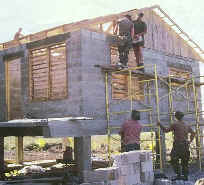 |
|
Schools and Medical
Clinics |
|
COSTA RICA |
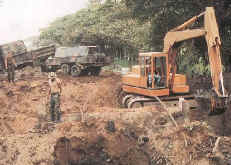 |
|
Roads and Bridges |
|
EL SALVADOR |
 |
|
Schools and Medical
Clinics |
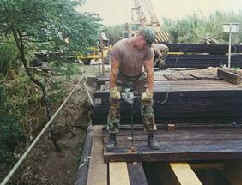 |
|
Roads and Bridges |
|

|
|
Drilling Water
Wells |
|
NICARAGUA |
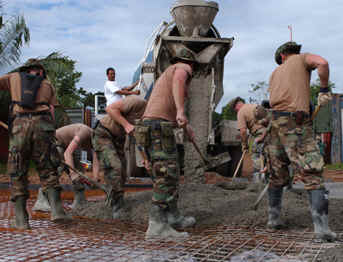 |
 |
|
Schools and Medical
Clinics |
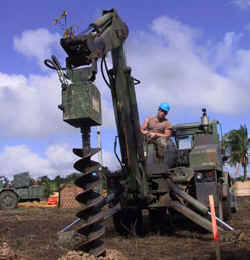 |
|
Drilling
Water Wells |
|
GUATEMALA |
|
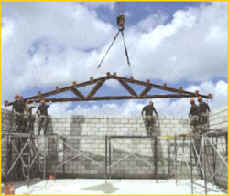
|
|
Schools and Medical
Clinics |
| |
| |
|
FAST FACT |
| 59
percent of the Army's Engineer Construction capability is in
the Army National Guard. |
|
| (From
Army National Guard website) |
| |
| |
|
TOTAL
FORCES CONCEPT |
| ARMY,
AIR FORCE, NAVY AND MARINES (Active Duty) |
| RESERVE
COMPONENT: |
| --
NATIONAL GUARD: |
| -----Army
National Guard |
| -----Air
National Guard |
| --
RESERVES: |
| -----Army,
Air Force, Navy/ Marines |
| CIVILIAN
EMPLOYEES |
| |
|